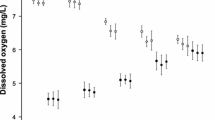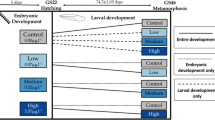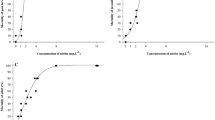Abstract
Ephemeral pools, which can have high animal biomass and low dissolved oxygen, may be prone to nitrite accumulation. As such, it is important to understand how exposure to nitrite might affect development and growth of amphibians that breed in these ephemeral pools. Wood frog (Rana sylvatica) and eastern tiger salamander (Ambystoma tigrinum tigrinum) embryos and tadpoles and young larvae were exposed to elevated concentrations of nitrite derived from sodium nitrite: 0, 0.3, 0.6, 1.2, 2.1, 4.6, and 6.1 mg l−1 NO2–N. Increasing nitrite exposure slowed embryonic and larval development in both the eastern tiger salamander and the wood frog, reduced growth in tiger salamander embryos and larvae, and delayed metamorphosis in the wood frog. At concentrations less than 2 mg l−1 NO2–N nitrite delayed hatching, and at concentrations above 2 mg l−1 time to hatching decreased causing more individuals to hatch at less developed stages. Nitrite also increased asynchrony in tiger salamander hatching. The sublethal effects of nitrite on amphibian development, growth and hatching could have serious repercussions on amphibian fitness in ephemeral environments. Potential increases in mortality on field populations caused by sublethal effects of nitrite are discussed.
Similar content being viewed by others
References
Berger L (1989) Disappearance of amphibian larvae in the agricultural landscape. Ecol Int J 17:65–73
Berven KA (1990) Factors affecting population fluctuations in larval and adult stages of the wood frog (Rana sylvatica). Ecology 71:1599–1608
Blaustein AR, Hoffman PD, Hokit DG, Kiesecker JM, Walls SC, Hays JB (1994) UV repair and resistance to solar UV-B in amphibian eggs: a link to population declines? Proc Natl Acad Sci USA 91:1791–1795
Bumb BL, Baanante CA (1996) World trends in fertilizer use and projections to 2020. International Food Policy Research Institute. 2020 Vision Brief 38:1–4
Carey C, Cohen N, Rollins-Smith L (1999) Amphibian declines: an immunological perspective. Dev Comp Immunol 23:459–472
Drickamer LC, Vessey SH (1986) Animal behavior: concepts processes and methods, 2nd edn. Wadsworth Publishing Company, Belmont
Duellman WE, Trueb L (1986) Biology of amphibians. Johns Hopkins University Press, Baltimore
Eddy FB, Kunzlik PA, Bath RN (1983) Uptake and loss of nitrite from the blood of rainbow trout, Salmo gairdneri Richardson, and Atlantic salmon, Salmo salar L. in fresh water and in dilute sea water. J Fish Biol 23:105–116
Environmental Sciences Section (1991) ESS method 220.3: ammonia nitrogen and nitrate + nitrite nitrogen, automated flow injection analysis method. Inorganic Chemistry Unit Wisconsin State Lab of Hygiene, Madison
Feder ME (1982) Effect of developmental stage and body size on oxygen consumption of anuran larvae. J Exp Zool 220:33–42
Gosner KL (1960) A simplified table for staging anuran embryos and larvae with notes on identification. Herpetologica 16:183–190
Griffis-Kyle KL (2005) Ontogenetic delays in effects of nitrite exposure on tiger salamanders (Ambystoma tigrinum tigrinum) and wood frogs (Rana sylvatica). Environ Toxicol Chem 24:1523–1527
Griffiths R, Beebee TJC (1992) Decline and fall of the amphibians. New Sci 134:25–29
Huey DW, Beitinger TL (1980a) Toxicity of nitrite to larvae of the salamander Ambystoma texanum. Bull Environ Contam Toxicol 25:909–912
Huey DW, Beitinger TL (1980b) Hematological responses of larval Rana catesbiana to sublethal nitrite exposures. Bull Environ Contam Toxicol 25:574–577
Jensen FB (1995) Uptake and effects of nitrate and nitrite in animals. In: Walsh PJ, Wright P (eds) Nitrogen metabolism and excretion. CRC, Boca Raton, pp 289–303
Kiesecker JM, Blaustein AR, Belden LK (2001) Complex causes of amphibian population declines. Nature 410:681–683
Lewis WM, Morris DP (1986) Toxicity of nitrite to fish: a review. Trans American Fish Soc 115:183–195
Mackerness CW, Keevil CW (1996) Origin and significance of nitrite in water. Chap 4. In: Hil M (ed) Nitrates and nitrites in food and water. Woodhead Publishing Limited, Cambridge, pp 77–92
Marco A, Blaustein AR (1999) The effects of nitrite on behavior and metamorphosis in Cascades frogs (Rana cascadae). Environ Toxicol Chem 18:946–949
Marco A, Quilchano C, Blaustein AR (1999) Sensitivity to nitrate and nitrite in pond-breeding amphibians from the Pacific Northwest, USA. Environ Toxicol Chem 18:836–2839
McCoy EF (1972) Role of bacteria in the nitrogen cycle in lakes. EPA 841/1972.1. United States Environmental Protection Agency. Water Pollution Control Research Series
National Atmospheric Deposition Program (NRSP-3) (2005) NADP, Program Office, Illinois State Water Survey, 2204 Griffith Dr., Champaign, IL 61820
Neter J, Kutner MH, Nachtsheim CJ, Wasserman W (1996) Applied linear statistical models, 4th edn. Times Mirror Higher Education Group, Chicago
Neuman D, Kramer M, Raschke I, Grafe B (2001) Detrimental effects of nitrite on the development of benthic Chironomus larvae, in relation to their settlement in muddy sediments. Archiv Hydrobiol 153:103–128
Phillips K (1990) Where have all the frogs and toads gone? Bioscience 40:422–424
Pounds JA, Crump ML (1994) Amphibian declines and climate disturbance: the case of the golden toad and the harlequin frog. Conserv Biol 8:72–85
Reaser JK (1996) The elucidation of amphibian declines. Amphib Reptile Conserv 1:4–9
Rice KC, Jung RE (2004) Water quality and amphibian population data for Maryland, Washington, DC, and Virginia 2001–2004. USGS report 2004–1401. Reston Virginia
Rouse J.D, Bishop CA, Struger J (1999) Nitrogen pollution: an assessment of its threat to amphibian survival. Environ Health Perspect 107:799–803
Sampaio LA, Wasielesky W, Miranda-Filho KC (2002) Effect of salinity on acute toxicity of ammonia and nitrite to juvenile Mugil platanus. Bull Environ Contam Toxicol 68:668–674
Shi DL, Boucaut JC (1995) The chronological development of the urodele amphibian Pleurodeles. Int J Dev Biol 39:427–441
Smith GR, Vaala DA, Dingfelder HA, Temple KG (2004) Effects of nitrite on Bullfrog (Rana catesbeiana) tadpoles from central Ohio, USA. Bull Environ Contam Toxicol 72:1012–1016
Stuart SN, Chanson JS, Cox NA, Young BE, Rodrigues ASL, Fischman DL, Waller RW (2004) Status and trends of amphibian declines and extinctions worldwide. Science 306:1783–1786
SPSS (1997) SPSS Base 7.5 for windows user’s guide. SPSS, USA
U.S. Environmental Protection Agency (1983) Methods of chemical analysis of water and wastes. EPA-600/4-79-020. Environmental Monitoring Systems Laboratory, Cincinnati
Vitousek PM, Aber JD, Howarth RW, Likens GE, Matson PA, Schindler DW, Schlesinger WH, Tilman DG (1997) Human alteration of the global nitrogen cycle: sources and consequences. Ecol Appl 7:737–750
Wellborn GA, Skelly DK, Werner EE (1996) Mechanisms creating community structure across a freshwater habitat gradient. Ann Rev Ecol Syst 27:337–363
Acknowledgements
Cedar Creek Natural History Area, Long Term Ecological Research Site (University of Minnesota) and Dr. Mark Ritchie (Syracuse University) provided funding and facilities for this research.
Author information
Authors and Affiliations
Corresponding author
Rights and permissions
About this article
Cite this article
Griffis-Kyle, K.L. Sublethal Effects of Nitrite on Eastern Tiger Salamander (Ambystoma tigrinum tigrinum) and Wood Frog (Rana sylvatica) Embryos and Larvae: Implications for Field Populations. Aquat Ecol 41, 119–127 (2007). https://doi.org/10.1007/s10452-006-9047-1
Received:
Accepted:
Published:
Issue Date:
DOI: https://doi.org/10.1007/s10452-006-9047-1




